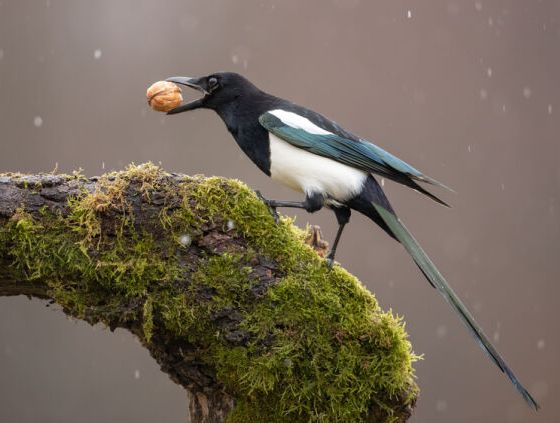
The magpie is a bird said to have a passion for thievery. It is popularly known as the thief magpie. This black-and-white bird owes its reputation to its love of shiny things, which it invariably drags back to its nest. It is also quite sociable, filling the surrounding area with a loud, chattering sound.
Not long ago, a tame magpie moved into my street. It's quite intelligent, readily interacts with people, and, naturally, as a typical member of this family of birds, it's a thief. Observing my new feathered acquaintance, I discovered that it's a very clever, cunning, and I would even say sly bird.
The magpie attracts attention not only with its loud chatter but also with its distinctive coloring. There are many interesting facts about this bird.
Its body length is approximately 50 cm, while its wingspan reaches about 90 cm. The tail is longer than the body.
The magpie is rightfully considered one of the most intelligent birds in the wild. These birds have their own specific social rituals that allow them to express emotions, including sadness.
Chatterbirds recognize themselves by looking in a mirror, while the same parrots perceive their own reflection as a different individual.
These birds do not settle in dense forest plantations; they like to live next to people.
Magpies have a good appetite. They enjoy both plant and animal food (insects, rodents, reptiles). They are not averse to raiding other birds' nests.
The Chinese believe that the magpie brings happiness and good luck, while the Slavs consider the chattering bird to be almost a spawn of hell.
Magpies build nests in a spherical shape with a hole that serves as their entrance.
To protect their offspring, these birds roost in flocks.
Magpies have a passion for shiny objects. They happily drag such trinkets into their nests. This brings joy to the bird and attracts mates.
The magpie buries its leftover food under trees, ready to retrieve it from its own cache when needed. This black-and-white bird never forgets where it hides its supplies.
Magpies feed on ticks, which they pick out of the fur of large mammals by sitting on their backs.
Magpies are sedentary birds, yet they are widespread throughout the world.
Before raising a family, a magpie builds about a dozen nests and then selects the best one. Extra nests distract predators from the chicks. The female lays a clutch of 7-8 eggs. The feathered mother incubates them for 18 days. The chicks fly away from the family nest at 30 days old.
Magpies are able to recognize people by face, an ability typically found only in domesticated animals.
It has been proven that magpies can be trained to count and clean their cage when kept in captivity.
Chatterbirds gather in groups to hunt other birds.
The ratio of this bird's body size to its brain mass is approximately the same as that of large primates.
The 14th century in Rus' was marked by Metropolitan Alexy's official ban on magpies approaching the capital. It was believed that witches, disguised as magpies, were flying into the city.
According to the beliefs of our pagan ancestors, a magpie could steal a child from the womb of a pregnant woman.
Magpies live up to 15 years, but there have been cases when these birds lived up to 30.
Magpies are intelligent birds, but people have mixed opinions about them. Some dislike them for their thievishness, brazenness, and noisiness. Others admire the intelligence and cleverness of these birds. Regardless, there are many interesting facts about magpies.





